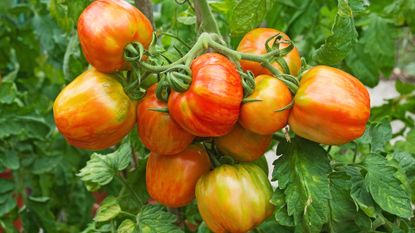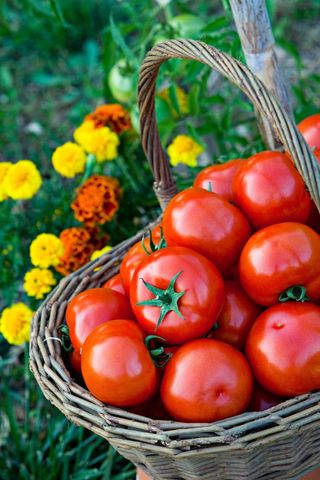Why are my tomatoes splitting? How to stop this common problem
Looking for a solution to stop your tomatoes splitting? This expert-approved tip is the key to a healthy crop this summer


Cracking and splitting tomatoes are amongst the most common problems green-thumbed growers face. While this much-loved crop is one of the easiest to grow, some seem to face damage around late summer – following months of varying temperatures and water levels.
The threat of a splitting tomatoes can feel like enough to deter you from growing tomatoes in the first place, but it shouldn't. While it is hard to guarantee your tomatoes won't split, once you know why it is happening there is a simple trick to help give them the best chance at success, which we reveal below.
Why are my tomatoes splitting?

According to expert Kate Russell from The Daily Garden, cracking and splitting of tomatoes occurs when the inside of a tomato grows faster than its outside. This can happen for a variety of reasons, including extreme heat, high humidity, heavy rains, and extreme temperature differences between night and day.
'Irregular watering can also cause blossom end rot, so proper irrigation is always a good idea when growing tomatoes,' she adds.
How to stop tomatoes splitting

Why do tomatoes split? There are three main reasons, and what you can do about them so that your vegetable garden ideas yield a good crop.
Over-enthusiastic pinching out
Kate Russell warns that removing too many leaves from your plant will encourage tomatoes to split by the end of summer. So, when you're next pinching out tomatoes, it is best to do so with caution.
Over-watering
Over-watering can cause cracks in the skins, too, so ensure you keep your watering routine to what's recommended, which is daily morning watering early in the season, then twice-daily watering as temperatures increase. Do this with cautious though: tomatoes only need up to two inches of water a week, with container-grown tomatoes needing more than those grown in borders.
Dry soil
You can use mulch to encourage tomatoes' health further. Cory Tanner, the horticulture program team director at Clemson University recommends adding 'mulch around your plants with a 2- to 3-inch layer of organic mulch (straw, leaves, etc.)'. This will conserve soil moisture.
'[You can] maintain even soil moisture by irrigating on a regular schedule between rains. Avoid extremes of dry and wet soil,' Cory adds.
Vegetable growing expert Brett White uses a similar method. However, he suggests opting for red plastic mulch [such as this on Amazon] that is designed to improve your tomato's health.
'This stops splitting because it reduces the amount of evaporation in the soil that takes place in hot weather, which allows the roots to access water for longer periods of time and in larger quantities,' he explains.
Will split tomatoes heal?
Horizontal cracks (concentric cracks) are usually mild and often heal; vertical cracks (radial cracks) are often deeper and less likely to heal. In fact, they'll usually get worse.
Can you eat split tomatoes?
You can eat split tomatoes if there is no fungus, insect or bacterial invasion, which should be obvious to the eye. If you see split tomatoes on your plant, it's usually best to harvest your tomatoes and let them ripen indoors where they can be better protected.
Sign up to the Homes & Gardens newsletter
Decor Ideas. Project Inspiration. Expert Advice. Delivered to your inbox.

Megan is the Head of Celebrity Style News at Homes & Gardens. She first joined Future Plc as a News Writer across their interiors titles, including Livingetc and Real Homes, before becoming H&G's News Editor in April 2022. She now leads the Celebrity/ News team. Before joining Future, Megan worked as a News Explainer at The Telegraph, following her MA in International Journalism at the University of Leeds. During her BA in English Literature and Creative Writing, she gained writing experience in the US while studying in New York. Megan also focused on travel writing during her time living in Paris, where she produced content for a French travel site. She currently lives in London with her antique typewriter and an expansive collection of houseplants.
-
 What is brutalist interior design? An expert guide to this distinctive look
What is brutalist interior design? An expert guide to this distinctive lookFall for the industrial materials, rugged textures, and monochromatic palette of brutalist interior design
By Sarah Warwick Published
-
 Taylor Swift embraces the modern rustic trend in one of her favorite recording locations – The Long Pond Studios
Taylor Swift embraces the modern rustic trend in one of her favorite recording locations – The Long Pond StudiosThe isolated recording studio in New York's Hudson Valley is an unexpected source of on-trend decorating inspiration, brought to light by Taylor Swift
By Sophie Edwards Published